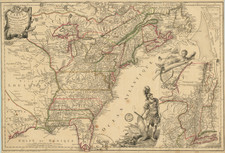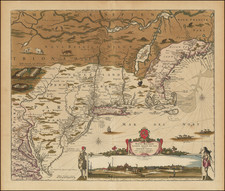Important American Revolutionary War Battle Plan, showing the Battle of Brandywine, published April 13, 1778 by William Faden in London.
The map identifies the disposition and movement of forces colored in red (British), blue (Hessian) and yellow (American).
Below the map, two sets of lettered references identify major elements of the Battle, movements etc.
The Battle of Brandywine was fought on September 11, 1777 and was one of the low points of the War for Americans. General Washington's near disastrous defeat, due in large part to his failing to protect his right flank, led directly to the British occupation of Philadelphia.
Faden's map accurately depicts the plan of battle, showing the American retreat toward Chester. The note below the title identifies Faden's source for the movements as a manuscript "Plan drawn on the Spot by S. W. Werner, Lieut. of Hessian Artillery."
Nebenzahl notes:
The complex of hills, ravines and creek beds is carefully delineated (very useful since terrain was important to the outcome) ... British troops are designated by regiment or battalion number.
The present example is an unusually fine dark impression, in original color.
William Faden (1749-1836) was the most prominent London mapmaker and publisher of the late-eighteenth and early-nineteenth centuries. His father, William Mackfaden, was a printer who dropped the first part of his last name due to the Jacobite rising of 1745.
Apprenticed to an engraver in the Clothworkers' Company, he was made free of the Company in August of 1771. He entered into a partnership with the family of Thomas Jeffreys, a prolific and well-respected mapmaker who had recently died in 1771. This partnership lasted until 1776.
Also in 1776, Faden joined the Society of Civil Engineers, which later changed its name to the Smeatonian Society of Civil Engineers. The Smeatonians operated as an elite, yet practical, dining club and his membership led Faden to several engineering publications, including canal plans and plans of other new engineering projects.
Faden's star rose during the American Revolution, when he produced popular maps and atlases focused on the American colonies and the battles that raged within them. In 1783, just as the war ended, Faden inherited his father's estate, allowing him to fully control his business and expand it; in the same year he gained the title "Geographer in Ordinary to his Majesty."
Faden also commanded a large stock of British county maps, which made him attractive as a partner to the Ordnance Survey; he published the first Ordnance map in 1801, a map of Kent. The Admiralty also admired his work and acquired some of his plates which were re-issued as official naval charts.
Faden was renowned for his ingenuity as well as his business acumen. In 1796 he was awarded a gold medal by the Society of Arts. With his brother-in-law, the astronomer and painter John Russell, he created the first extant lunar globe.
After retiring in 1823 the lucrative business passed to James Wyld, a former apprentice. He died in Shepperton in 1826, leaving a large estate.









![[Rare First State] Novissima Tabula Regionis Ludovicianae Gallice dictae la Louisiane . . .](https://storage.googleapis.com/raremaps/img/small/72622.jpg)
![[New England] Tierra Nueva](https://storage.googleapis.com/raremaps/img/small/64626.jpg)

![[The First Maps Printed Color] Cartes en Couleur des Lieux Sujets aux tremblements de Terre Dans toutes les parties du Monde Selon le Sisteme de l’impulsion Solaire](https://storage.googleapis.com/raremaps/img/small/52293op.jpg)

